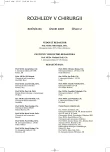Laparoscopic Liver Resection
Authors:
L. Hnízdil; T. Novotný; P. Piskač
Authors‘ workplace:
II. chirurgická klinika, Brno, přednosta: doc. MUDr. Z. Gregor, CSc.
Published in:
Rozhl. Chir., 2007, roč. 86, č. 2, s. 89-91.
Category:
Monothematic special - Original
Overview
Rapid development of liver surgery in the last 25 years results from introduction of new procedures entailing an increase in the number of operated patients, and simultaneously a reduction in risk of the surgery and subsequent postoperative morbidity and mortality. They include standard preoperative examination completed by new high-resolution diagnostic methods (duplex ultrasound, spiral CT, liver scintigraphy, PET) which can better reveal the pathological focus in relation to liver anatomy and largely contribute to the consideration of resecability of the liver affection [1]. Standard resection technique is, in addition to the advantage of an anatomical resection, completed with modern technology which helps to reduce the blood loss and ischemic damage to the remaining liver parenchyma especially in non-anatomical resections. Nowadays, liver resections are performed by a combination of various techniques. One of them is a liver parenchyma resection using a harmonic scalpel [2] in the classical surgical procedure. There are also mini-invasive laparoscopic operations, and recently robotic resections which can’t be done without the harmonic scalpel [3, 4].
The authors present a case report of a 25-year-old woman who developed spastic pain in the epigastrium three years ago. Sonography, CT, MR, liver scintigraphy and, last but not least, diagnostic laparoscopy were used for accurate diagnostics. Diagnostic laparoscopy was performed in order to confirm the diagnosis, extent of surgery and especially the possibility of performing laparoscopic liver resection. This was carried out using the harmonic scalpel which is the method of choice especially in non-anatomical resection for better control of bleeding and safer isolation of bile ducts and vessels.
Key words:
focal nodular hyperplasia – diagnostic laparoscopy – laparoscopic resection
Sources
1. Vyhnálek, F., Denemark, L., Hořejšová, M., Krtek, V. Současný stav resekce jater metastazy karcinomu tlustého střava a konečníku. Rozhl. Chir., 1999, roč. 78, s. 533–537.
2. Vyhnálek, F., Fanta, J., Denemark, L., Horák, L. Resekce jater s použitím harmonického skalpelu. Rozhl. Chir., 2000, roč. 79, č. 5, s. 241–244.
3. Felicioni, L. (Dept. of Surgery, Grosseto, Italy) Update on advanced applications od da Vinci System in General Surgery. I. kongres robotické chirurgie, říjen 2006, Brno.
4. Ryska, M., Langer, D., Rudiš, J., Pudil, J. Robotická resekce jater. I. kongres robotické chirurgie, říjen 2006, Brno.
5. Černý, J. a kol. Chirurgia brušných orgánov a retroperitonea, 1992.
6. Šimonovský, V. Benigní jaterní tumory – tomografické zobrazovací metody. Fokální nodulární hyperplazie a hepatocelunární adenom. Čes. Radiol., 54, 2000, No. 2, p. 71–77.
7. Klompmaker, I. J., Sloof, M. J., van der Meer, J., deJong, G. M., de Bruijn, K. K., Bamns, J. Orthopic liver transplantation in a patient with a giant cavernosus hemangioma of the liver and Kasabach-Meritt syndrome. Transplantation, 48, 1989, p 149.
8. Vyhnálek, F., Denemark, L., Ducháč, V., Čáp, F. Kdy je indikována resekce u primárních nádorů jater? Rozhl. Chir., 2002, roč. 81, č. 4, s. 196–200.
9. Foley, W. D., Jochem, R. J. Computed tomography. Focal and diffuse liver disease. Radiol. Clin. N. Amer. 29, 1991, s. 1213–1233.
10. Demiryurek, H., Alabaz, O.,Agdamir, D., Sungur, I., Erkocak, E. U., Akinoglu, A., Alparslan, A., Zorludemir, S. Symptomatic giant cavernosus haemangioma of the liver – is enucleation a sefe method? A single institution report. HPB Surgery. 10(5): 299–304, 1997.
11. Král, V., Neoral, Č., Aujeský, R. Benigní léze jater a jejich chirurgická léčba. Rozhl. Chir., 76, 1997, No. 2, p. 59–61.
Labels
Surgery Orthopaedics Trauma surgeryArticle was published in
Perspectives in Surgery

2007 Issue 2
Most read in this issue
- Biliary Ileus – A Missed Out Cause of Intestinal Obstruction
- Appendectomy – Comparison of Results of Laparoscopy versus Open Surgery
- Multiple Lung Metastasectomy for the Poor Differentiated Metastatic Synovial Sarcoma
- Laparoscopic Liver Resection
